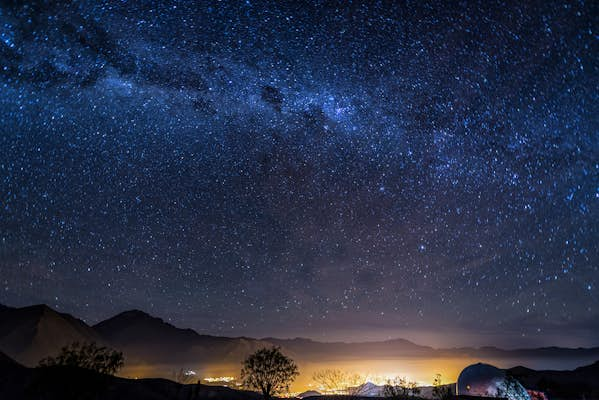Near the southern edge of the vast Atacama Desert, mountain rivers wind their way through a sun-baked landscape of vine-covered hillsides and serene villages, with Andean peaks looming on the distant horizon. This is the Elqui Valley, famed for its rain-free climate (over 320 days of sunshine) and remarkably clear skies.
Given its remote location, high elevation and reliably cloud-free nights, the valley is one of the best places on earth for stargazing. Major observatories dot the desert landscape, and back in 2015, the entire valley (encompassing more than 90,000 acres) was declared the world’s first International Dark Sky Sanctuary during the General Assembly of the IAU (International Astronomical Union).

Astronomers have long known about this unique place nestled between the Andes and the Pacific Ocean, just over 500km north of Santiago; it’s home to four major astronomical research bases. In recent years, astro-tourists have also discovered its charms, and there are a growing number of ways to experience those magnificent star-filled night skies. The big date many stargazers have penciled on their calendars is July 2, 2019. Just before dusk, a total solar eclipse will pass over the western skies, and this is one of the best places in the world to see it.

Observatory central
The small village of Vicuña makes an ideal base for exploring the valley. Near here, a number of observatories offer guided viewings of the night sky. The Observatorio Cerro Mamalluca, some 9km northeast of Vicuña, is among the best known, and offers big-group bilingual tours and the chance to peer through 30cm (12-inch) telescopes at the moon, planets (Jupiter, Saturn) and various constellations. A short introduction provides a crash course in astronomy, followed by celestial viewings led by knowledgeable guides.

The Observatorio del Pangue is situated around 17km south of Vicuña in an area with complete absence of light pollution. In fact, the only human-made structures in view are are the nearby scientific observatories of SOAR, Gemini, and Tololo. Enthusiastic astronomers lead small-group tours (maximum of ten people), on two-hour viewings, with a look at distant galaxies, nebulae, star clusters, and of course our own nearby planets through the T400, a computerized 16-inch (40cm) telescope. More avid stargazers can opt for three-hour sessions, which include a look through the T600, a 25-inch (64cm) telescope. All tours are offered in Spanish, English or French. Amateur astronomers and astrophotographers with the interest and time (and cash) can hire out the whole facility for an in-depth evening exploring the night sky.
Surrounded by vineyards just outside of Vicuña, Alfa Aldea is run by garrulous astronomers who lead small-group sessions under the starry skies. The visit starts with a short intro to observable phenomena, as well as the opportunity to listen to the stars via radio telescopes. This is followed by guided viewing in the open-air amphitheater (laser pointers pinpoint near and distant stars and planets) and a look through Alfa Aldea’s scientific-grade telescopes. A welcome drink (a Chilean red wine made from the property’s vines) and steaming cups of vegetable soup, plus blankets on especially cold nights, help cut the evening chill.

Star-powered towns
Around 40km southeast of Vicuña, the tiny village of Pisco Elqui is also a fine destination for stargazers. Charming B&Bs with lush gardens and spacious terraces are ideal spots for watching the sunset followed by a quickly darkening sky light up with stars. Although there are no observatories in the area, operators like Turismo Dagaz lead astrotours outside the village in lovely mountainous areas.
While you’re in the area, you can take advantage of another stellar phenomenon — the restaurants of Villaseca that use solar ovens to cook their food. Around 5km southeast of Vicuña, several family-run restaurants harness the rays of the sun in custom-built outdoor ovens to bake bread, roast meats and fire up leche asada (flan) for dessert. Among the best of the bunch is Delicias Del Sol.

Make it happen
There are a few things to keep in mind before booking your trip to the valley. Be sure to check the lunar calendar for your proposed dates. When the moon is in its fullest phase (around four days either side of the full moon), strong moonlight greatly diminishes viewing of the night sky, and it’s a bad time to be peering through telescopes at distant galaxies. Whenever you go, be sure to bring warm clothes, as it can get cold at night in the desert. If you’re traveling with kids, check minimum age requirements with your chosen observatory. Some don’t allow visitors under the age of 16.
Also, don’t neglect to make contact before you arrive. Many places close during the winter (June to August – though 2019 will be an exception owing to the solar eclipse), and others book up for private events. To avoid disappointment, get in touch well in advance of your departure. All of the above places offer optional transport to the facility – a wise investment even if you have your own rental vehicle since traveling these narrow, remote mountain roads in the dark can be dangerous.
Related articles:
This article was originally published in August 2018 and refreshed in June 2019.
https://shop.lonelyplanet.com/products/lonely-planets-best-in-travel-paperback-2019
